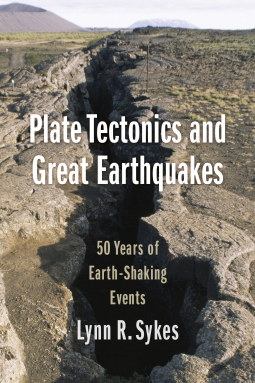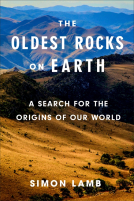
Plate Tectonics and Great Earthquakes
50 Years of Earth-Shaking Events
by Lynn R. Sykes
This title was previously available on NetGalley and is now archived.
Send NetGalley books directly to your Kindle or Kindle app
1
To read on a Kindle or Kindle app, please add kindle@netgalley.com as an approved email address to receive files in your Amazon account. Click here for step-by-step instructions.
2
Also find your Kindle email address within your Amazon account, and enter it here.
Pub Date Jun 04 2019 | Archive Date Sep 24 2019
Talking about this book? Use #PlateTectonicsAndGreatEarthquakes #NetGalley. More hashtag tips!
Description
Sykes combines lucid explanation of how plate tectonics revolutionized geology with unparalleled personal reflections. He entered the field when it was on the cusp of radical discoveries. Studying the distribution and mechanisms of earthquakes, Sykes pioneered the identification of seismic gaps—regions that have not ruptured in great earthquakes for a long time—and methods to estimate the possibility of quake recurrence. He recounts the various phases of his career, including his antinuclear activism, and the stories of colleagues around the world who took part in changing the paradigm. Sykes delves into the controversies over earthquake prediction and their importance, especially in the wake of the giant 2011 Japanese earthquake and the accompanying Fukushima disaster. He highlights geology’s lessons for nuclear safety, explaining why historic earthquake patterns are crucial to understanding the risks to power plants. Plate Tectonics and Great Earthquakes is the story of a scientist witnessing a revolution and playing an essential role in making it.
Advance Praise
"Lynn Sykes, one of the scientific revolutionaries who gave us plate tectonics, tells his story, with special emphasis on earthquake prediction. Although earthquake prediction has been a topic perceived by some as pursued only by “fools and charlatans,” Sykes defends it not only as worthy of pursuit, but also, however imperfect, as likely to be societally valuable."
-Peter Molnar, Distinguished Professor of Geological Sciences, University of Colorado Boulder
Available Editions
| EDITION | Other Format |
| ISBN | 9780231186889 |
| PRICE | $35.00 (USD) |
Average rating from 6 members
Featured Reviews
This book gives a detailed description of all the research the author has done on earthquakes and tectonic plates. Many research papers are being named in the book. I found the chapters about eathquake prediction and about the relation of earthquakes to the nuclear disasters in Japan most interesting.
Great book, clearly a lot of work has gone into it. It is not for casual readers though, you have to have some interest in geophysics to be able to enjoy it fully. I am not a trained geophysicist, but a biologist so for me it was sometimes a little too specific. The images and pictures are helpful and aid the story. Tip: there's a helpful glossary at the end of the book!
 Claudia D, Reviewer
Claudia D, Reviewer
Truth to tell, I’m disappointed. I thought I’ll get more info on the actual earthquakes around the world, with facts, effects and consequences, what triggered them and some details regarding the tectonic plates and their movement.
Indeed, we get some of that, however, regarding earthquakes, there are few details on the major ones from Chile and Japan, with a notable mention of the one around San Francisco and that’s about it.
In rest, half of it consists in an autobiography and a lot of references to scientific papers the author wrote during his life, which bored me to death. The author is a personality in the field, with major contribution on tectonic plate theory, but I guess his writing style is more suited for scientific papers or speaking at conventions than writing a book for a wider audience.
This is no book of popularizing science; it is more for young geologists who want to further study this field or for other scientists who want to broaden their knowledge in other fields.
There are too many technical details and numbers which for me were just tedious to follow. I did learn some interesting facts about the mechanics of the plates and what’s behind their movement but too few.
Anyway, it was an experience and I’m sure those who are more than just mildly interested in this domain will find it more relevant than me.
AUTHOR’S BIO
Lynn Sykes is a Higgins Professor Emeritus, of Environmental Earth Sciences at Columbia University’s Lamont-Doherty Earth Observatory. Sykes graduated with a Bachelor of Science (B.Sc.) and Master of Science (M.Sc.) in geology from MIT in 1960. Later Sykes attended Columbia University where he earned his Doctorate in seismology in 1965. Three years later Sykes became a faculty member and was named the Higgins Professor of Earth and Environmental Sciences. He taught geophysics, plate tectonics, and environmental hazards. Sykes became a member of the staff of the Lamont-Doherty Earth Observatory of Columbia University in 1965 and remained there until 2005 when he retired as a professor emeritus.
Dr. Sykes is a member of the National Academy of Sciences and the American Academy of Arts and Sciences. He is a fellow of the Geological Society of America and the American Geophysical Union which honored him with its Macelwane and Bucher Awards. Although Dr. Sykes is currently retired, he continues his lifelong research on earthquakes and nuclear explosions.
WHO IS THE TARGET AUDIENCE?
Professor Sykes ‘a posteriori’ writing style combined with the lack of ‘layman’ terms could prove to be off putting for those who are unlettered. Despite this, the science is well described and completely comprehensible to those with even a fundamental comprehension of basic High School science. For these reasons I would suggest that this manuscript is best suited to individuals with a strong interest in the subject or a broad knowledge of the science. Students of earth sciences, geophysics, oceanographers, and those who lecture in any of these subjects are the target audience. Those who would like to know more about the life and times of Dr. Skyes may appreciate the detailed biographic information about the scientist, his academics and his social journey.
SYNOPSIS
The manuscript is very well written and is replete with an abundance of facts relating to the geologic sciences. In chapter one, Sykes provides a brief informative introduction on the subject. He has taken the time to provide beautifully detailed colored plates that significantly improve the understanding of the subject.
I the next chapter Dr. Sykes introduces himself. I note that some reviewers saw this as a negative aspect of the volume; I did not, I found it both fascinating and elucidating. His qualifications clarified the extensive education and of over half a century of experience that collectively with his illustrious academic background supports the science in his text.
The following chapters, except for one, focused on complex and detailed information communicated via glorious full color plates, diagrams, photographs, and graphs.
Within these chapters there are repeated mentions of the illustrious and notable, J. Tuzo Wilson (Ph.D.) of Toronto University. It was Dr. Wilson who recognized and originated the Theory of Transform Faults, a radically innovative method of earthquake study and analysis. Dr. Wilson is referenced 21 times throughout the book. Whilst the eminent German Geophysicist, Meterologist, and acknowledged originator of the Continental Drift Theory Dr. Alfred Wegener Ph.D. is only mentioned once. I considered the limited discussion on Dr. Wegener’s work on Continental Drift to be concerning. It was, after all, Dr. Wilson’s theory that ultimately led to today’s model of Plate Tectonics.
CONCLUSION
Whilst the Plate Tectonics and Great Earthquakes cannot be described as scintillating or thrilling read it is informative, knowledgeably written, and full of a wealth of valuable information. The volume can undoubtedly prove to be a challenging read. However, if you apply yourself and commit to completing the book, your reward will be an improvement in understanding a modern and increasingly relevant scientific discipline.
If I entertained any suggestions for improvements to the layout of the book; I would suggest that the plates are placed in-situ with the relevant chapter and not collated in the rear. I found it incredibly tedious and time asking to move back and forth to examine the graphics.
I found the glossary and references to be clear, concise, and useful.
ACKNOWLEDGEMENT
My sincere thanks go to: The Author, NetGalley, and Columbia University Press, for affording me the opportunity to review Plate Tectonics and Great Earthquakes.





